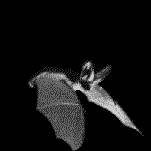



That's because the oldest fossil bats look remarkably like modern ones, each having wings formed from membranes stretched between long fingers, and ear structures designed for echolocation. No fossils of an animal intermediate between bats and their non-flying mammal ancestors have been found.
Now Karen Sears, at the University of Colorado Health Sciences Center in Denver, has discovered why intermediate forms may be missing in the fossil record. In a bid to understand where bats' specialised finger digits evolved from, Sears compared their embryological development with that of the finger digits of mice. In both animals, digits form from cartilage cells which divide and mature into bone in regions called growth plates.
But in bats, a key region of the growth plate called the hypertrophic zone is much larger than in mice, which allows their digits to grow much longer. That difference is controlled by a single gene known as BMP2, one of a family of genes important for limb development in mammals. Sears found that a protein produced by BMP2 is present in the hypertrophic region of bats, but not in mice. When she applied the protein to the digits of mouse embryos growing in the lab they elongated just like bat digits. Sears believes that bats began to evolve when this one gene became activated. Although it is a small developmental change, if it allowed the ancestors of bats to grow extended digits it could explain how bats evolved flight so rapidly, Sears told the Society of Vertebrate Paleontology meeting in Denver.
Relatively few transitional forms would have existed just briefly before being displaced by more advanced forms. "We've never had an adequate explanation" for the sudden appearance of bats, Nancy Simmons of the American Museum of Natural History in New York told New Scientist. "This sounds like a remarkable discovery." The lack of transitional forms has also led to speculation about the origin of bats, with some believing that primates are their closest relatives. Genetic studies now show they are closest to ferungulates, which include horses and pigs, or to the shrews and moles.
November 11, 2004
BACK (Origin of flight)NEW SCIENTIST

Museum of Southwestern Biology Division of Mammals